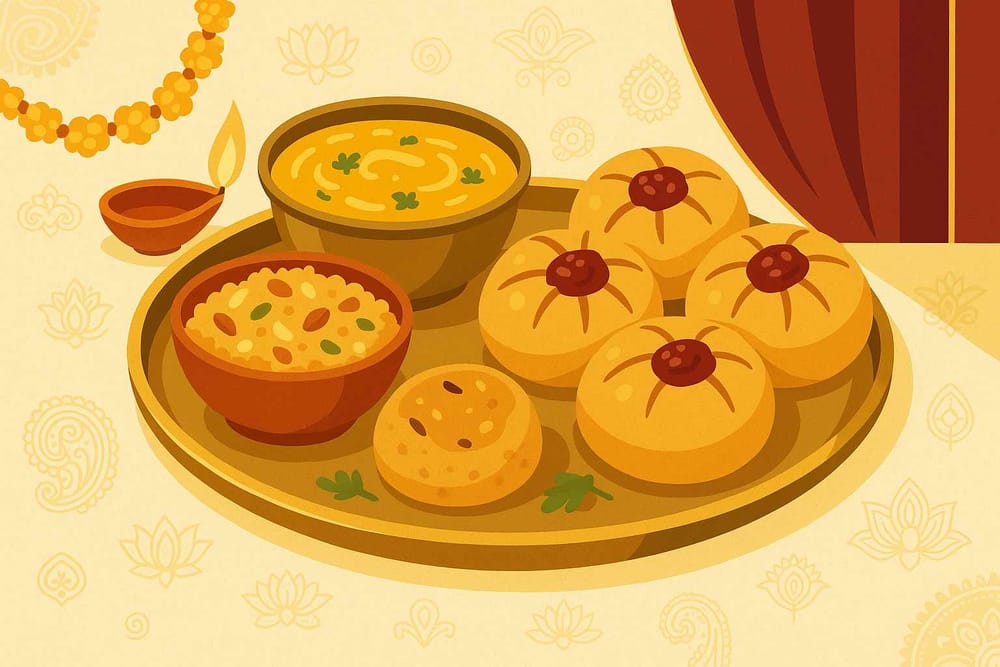
Dal Baati Churma: Festive Significance Explored
There are some smells that instantly take you back home, aren't there? For me, it's the rich aroma of ghee melting on a hot, freshly roasted baati. It’s a fragrance that speaks of festivals, of family gatherings where laughter echoes through the house, and of a meal that’s more than just food—it's a feeling. Dal Baati Churma is not just a dish; it's an experience, a beautiful story of Rajasthan's culture served on a platter.

The Soul of the Dish: What Each Component Represents
Ever wondered why this combination feels so complete? It’s because each part plays a unique role, creating a perfect balance that reflects the philosophy of Indian cuisine. Together, they tell a story of a life that is wholesome and fulfilling.
- The Nourishing Dal: This isn't just any lentil soup. It's a slow-cooked, spicy concoction, often made with a mix of lentils like toor, chana, and moong. The dal represents nourishment and the comforting, grounding aspects of life. It’s the warm hug on a plate that holds the entire meal together.
- The Mighty Baati: These are hard, unleavened wheat balls, traditionally roasted over hot coals or in a clay oven until they are crisp on the outside and soft inside. The Baati signifies strength and resilience. It’s a testament to the hardy spirit of the land and its people.
- The Sweet Churma: This delightful dessert is made by crumbling the baatis and mixing them with generous amounts of ghee, jaggery, or sugar. The churma stands for the sweetness and celebrations in life. It’s the joyous end to a hearty meal, a reminder of the happy moments we cherish.
A Journey Through Time: The Dish of Warriors
The story of Dal Baati Churma takes us back to the rugged lands of Rajasthan, where it was born out of necessity. It was the preferred meal for the Rajput warriors. Why, you ask? Because the baatis had a long shelf life and required very little water to prepare, making them the perfect food for long, arduous war campaigns. It is said that the soldiers would bury the dough in the hot desert sand in the morning, and by evening, the sun would bake them into perfect, hard baatis.
And what about the churma? Legend has it that it was created by accident! A cook in the royal court of Mewar accidentally poured sugarcane juice over some baatis. The result was so delicious that it became a permanent part of the meal. This simple, resourceful meal of warriors slowly transformed into a royal delicacy, symbolising both resilience and prosperity.
A Symbol of Celebration and Togetherness
Today, Dal Baati Churma is at the heart of every major celebration in Rajasthan and beyond. Be it the vibrant festival of Holi, the sparkling lights of Diwali, or a grand wedding, its presence is almost a given. Serving this meal is considered a mark of great respect and warm hospitality, a way of saying, "You are special to us."
The generous use of ghee is not just for flavour; it's a symbol of prosperity and well-being. The act of sitting together, breaking the baati with your hands, dipping it in dal, and enjoying it with a side of sweet churma creates a bond. It’s a communal dining experience that strengthens family ties and friendships, turning a simple meal into a joyous occasion.
Exploring these deep-rooted traditions helps us connect with our heritage on a more profound level. It's a journey into timeless wisdom that platforms like Bhaktilipi are dedicated to preserving. If you love understanding the stories behind our rituals, you might enjoy exploring our welcome journey into devotion and timeless wisdom.

Modern Twists on a Classic Tale
While the classic recipe is cherished, the dish has beautifully adapted over time. You'll find variations across different regions. For instance, in some parts of Madhya Pradesh, you might find baatis stuffed with spicy fillings. The modern kitchen has also brought its own changes. Many of us now wonder if Dal Baati Churma can be made healthier. Of course, it can! You can bake the baatis in an oven instead of frying them in ghee, use whole wheat flour, and reduce the amount of sugar in the churma to create a lighter version that still tastes wonderful.
Bringing the Tradition Home
Dal Baati Churma is so much more than a culinary delight; it's a celebration of our roots, our history, and the simple joy of sharing a meal with loved ones. Every bite is a reminder of the resourcefulness of our ancestors and the warmth of Indian hospitality.
So the next time you prepare this meal, remember the stories it holds. Let the aroma fill your home not just with the promise of a delicious meal, but with the spirit of togetherness and tradition. Honouring our heritage has never been easier, and it’s a beautiful way to keep these timeless traditions alive for generations to come.
At Bhaktilipi, we believe in sharing these timeless stories that inspire and connect us to our culture. We invite you to explore more such devotional and cultural narratives with us. Stay in touch and enrich your spiritual journey by following us on social media.
A passionate group of people dedicated to preserving India's knowledge of Dharma, Karma, and Bhakti for ourselves and the world 🙏.
